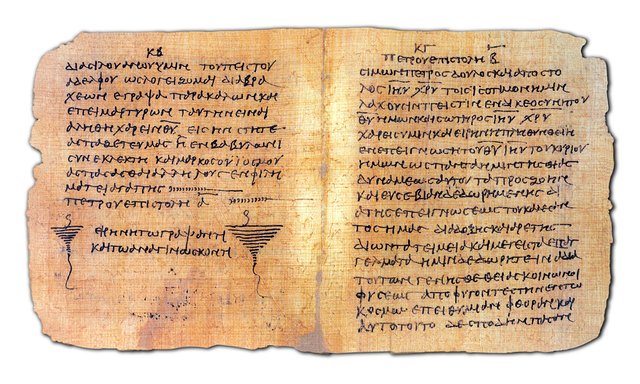"Tome" with marginal notes and paragraphs
The role was not, as one often thinks and as it is sometimes seen in films, rolled from top to bottom, but to the side. She was held with her left hand and rolled up with her right hand; for ease of handling, the roll was wrapped around a rod provided with a button (omphalós). The text was in individual columns, the columns, set off and had a wide edge. This offered space for marginal and intermediate remarks, the scholias, glosses or marginalia. Individual sections were separated by a character, the paragraph. The piece with the finished text column was rolled up again. From this typical handling of rolling comes the expression volume, "Tome," for a band. If a work like the Aeneid consists of twelve books, it means that it was written on twelve rolls of papyrus. The author was able to anticipate the space requirements of his work in advance and to create the appropriate caesura. After completing the reading, the papyrus was "rewound" like a movie. The individual roles were kept in a box or on a shelf, a "Biblio counter". From the top of the scroll hung a small strip, the titulus, with the name of the author and the work. If you wanted to send a single roll or take it with you when traveling, it was tied up and sealed, depending on its importance several times. It was then "a book with seven seals," as later the Secret Revelation of John. In Athens were already in the 5th century BC. For example, copies of a copy of Homer that had been carefully checked and cleaned of additives. Then came the dramas and comedies that had been performed and honored in Athens at the Great Dionysia Theater Competition. The writings of the philosophers were also available in bookstores in Athens.
The Library of Alexandria - Bookworm's Wonder of the World
Collecting books was a passion of the Hellenistic rulers; Aristotle was one of the first private individuals known to have a larger library. The Greek scholars of Alexandria can claim the fame of having set up the first library for scientific and research purposes, with the Ptolemaic kings around 280 BC. Occurred as founder and patron. This library was housed in a large building called Museion, a place dedicated to the muses. There were also statues of gods and famous poets: in the museum. The connection between the museum and the library is still known today, as in London the British Museum and the British Library with its famous reading room. The Museion of Alexandria was also a research center, an academy. The kings appointed scholars of all kinds, who generously paid and were exempted from taxes and were free to devote themselves to their studies. Among them were scientists like Euclid and doctors like Erasistratos, as well as librarians and philologists who all collected Greek literary works. Text critique and clarification were systematically carried out here, biographical details of the authors were compiled, and their work was preceded by a biography: the beginning of the biography. There have been several editions of the important authors, such as Homer, which have been compared. This explains the fabulous number of 700,000 scrolls the Museion of Alexandria was said to have had in its heyday.

